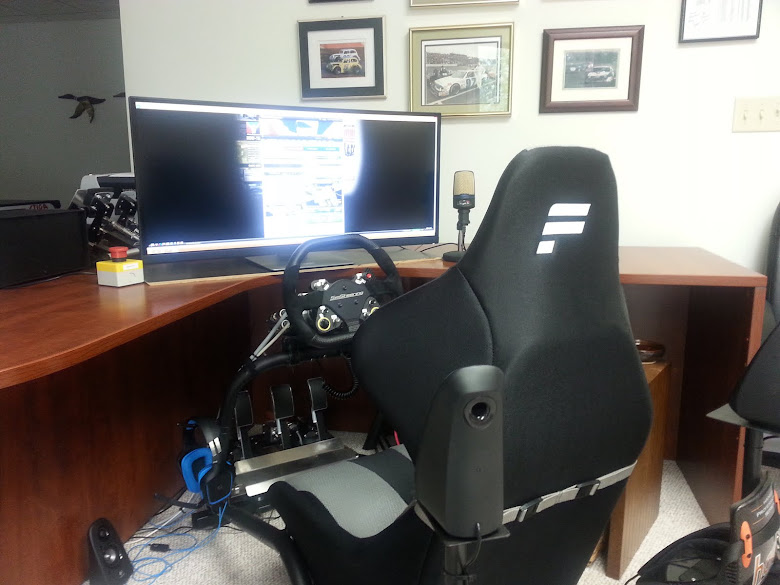I tested the car at Talladega
Speedway in order to test at the highest speed possible. Telemetry was used to
determine dynamic ride heights.
(On this
oval track, Diffuser settings are limited by iRacing to Sidewalls and Strakes
both OFF. On medium length speedways,
iRacing allows Sidewalls ON, Strakes OFF and on some shorter tracks they allow
Sidewalls and Strakes both ON.)
Front and rear wings were set
at their minimum settings. The results of many laps found that the
optimum “least drag=most speed” was produced with “dynamic” ride heights of
1.000” front and 1.350” rear when traveling 233-234 mph on a straight section of the track. This was
counter to “rules of thumb” promoted by others indicating that a “nose up”
attitude produced less downforce and drag.
At speeds of 233-234 mph, the downforce with
these ride heights produced having the lowest wing settings allowed (-4.5/-10.5)
was: Front: 420#; Rear 1200# as
determined by spring deflection using 1:1 motion ratio. (Note: An exact motion ratio of ride height
change to spring deflection is not available from public information so actual
downforce figures should be considered to be approximate. It is assumed in this
discussion that the ratio is different in the front vs the rear so downforce
figures for the front are doubled.) Front: 840#; Rear 1200# as
determined by estimated spring deflection using “estimated” motion ratio.
Initial “Static” ride height
would be depending on the springs chosen.
For example: (2) 2800# front springs would compress 0.075” inches each (420x2=840#
front downforce) so static ride height in the example above is 1.075” static
front ride height; (2) 1500# rear
springs would compress 0.40” (1200# rear downforce) so static ride height in
the example above would be 1.750”.
Spring rate choice affects
handling, depending on track bumps and the transition from banked turns and
less banked straights. (For example, the car at Talladega became very difficult to drive with rear springs stronger than 1500# as the transition from banked turn to straightaway creates a loose condition.) In general, from an strictly aerodynamic standpoint on ovals, the stiffer the better as the ideal "aerodynamic attitude" is maintained.
The next test was to learn
how lowering the ride height would affect drag.
The car was lowered enough that it almost bottomed on the right side in the corner banking
but the 0.35” front to rear “dynamic” rake was maintained on the straights. Dynamic ride heights were 0.700” front and
1.050” rear. Speed and lap time dropped off approximately 2%.
At speeds of 229-230 mph, the
downforce with these ride heights produced while still having the lowest wing
settings allowed (-4.5/-10.5) was: Front
1000#; Rear 1500#. Conclusion, lowering ride
height will increase downforce AND drag.
Another test was made that
produced a dynamic ride height of 0.500” front and 0.850” rear. Here the car
bottomed out in the corners, but still a downforce calculation was made on the
straights: Front 1600#; Rear 1600#. Conclusion, lowering dynamic front ride height
to 0.500” dramatically increases front downforce. The iRacing front to rear downforce calculator does not show this. (This has important implications for the DW12 on road course, however there, the third spring must be taken into account.)
The Diffuser Wicker created a very slight increase in drag and 25#
rear downforce. It is recommended that
in most cases—set this diffuser at ¾” Sealed as its use will allow a very
slight decrease in rear wing.
Each “click” of the front wing increased front
downforce by approximatley 20#, e.g. 6 clicks produced a change of 120#. Each click of the rear wing increased rear
downforce by approximately 6.5#,
e.g. 18 clicks produced a change of 120#. The ratio of #/click front to rear was not
linear. The higher the wing settings, the more the rear wing changes per click
in proportion to the front. So on low wing settings, the ratio might be 4
clicks rear for each one click front, but at higher wing settings, the ratio is
closer to 2 or 3 clicks rear for each click front. (These ratios are affected by wing wicker
settings.)
On tracks where turning “grip” is relatively
more important than maximum straight line speed, downforce is improved by
lowering the car, front and rear to the lowest possible dynamic ride height
with minimum bottoming. Maximum use of
the diffuser or “wing under the car” also produced the best results—maximum wicker
and maximum sidewall/strakes available. This usually requires stiffer rear springs and
often results in front and rear dynamic ride heights being equal. (It is suspected that the “faster with nose up”
rule of thumb is related to reducing rear ride height to lower the car—this does
not increase top speed, but does increase downforce and speed through the
corner, and therefore may increase speeds on the straights.)
Keep in mind that there are many, many variables that affect handling and speed. Finding the perfect setup for best lap times still takes experimental trial and error testing. The knowledge above only serves to help us "zero in" faster on the best result.
Donald Wayne Strout 10/28/2015
Keep in mind that there are many, many variables that affect handling and speed. Finding the perfect setup for best lap times still takes experimental trial and error testing. The knowledge above only serves to help us "zero in" faster on the best result.
Donald Wayne Strout 10/28/2015

